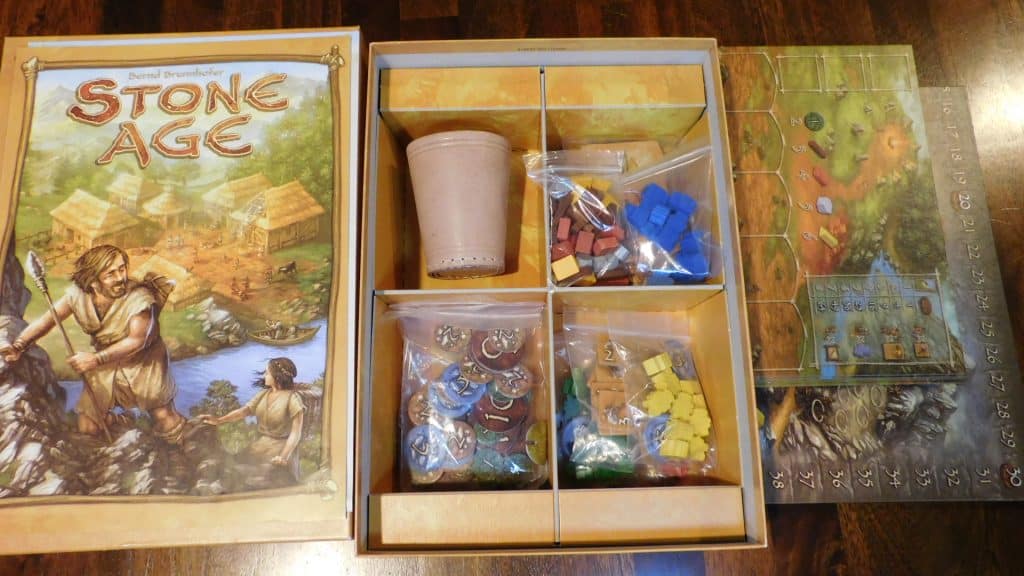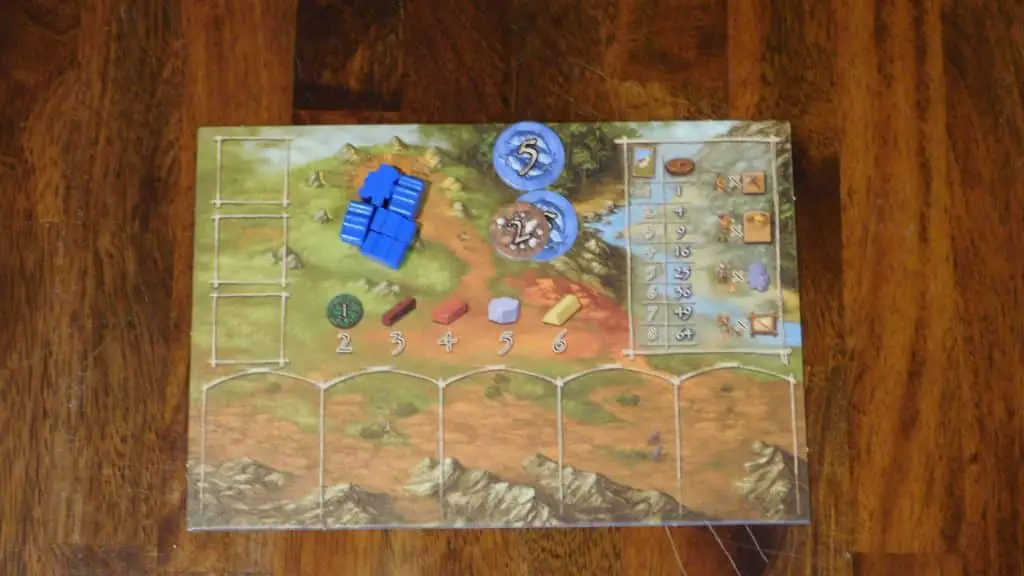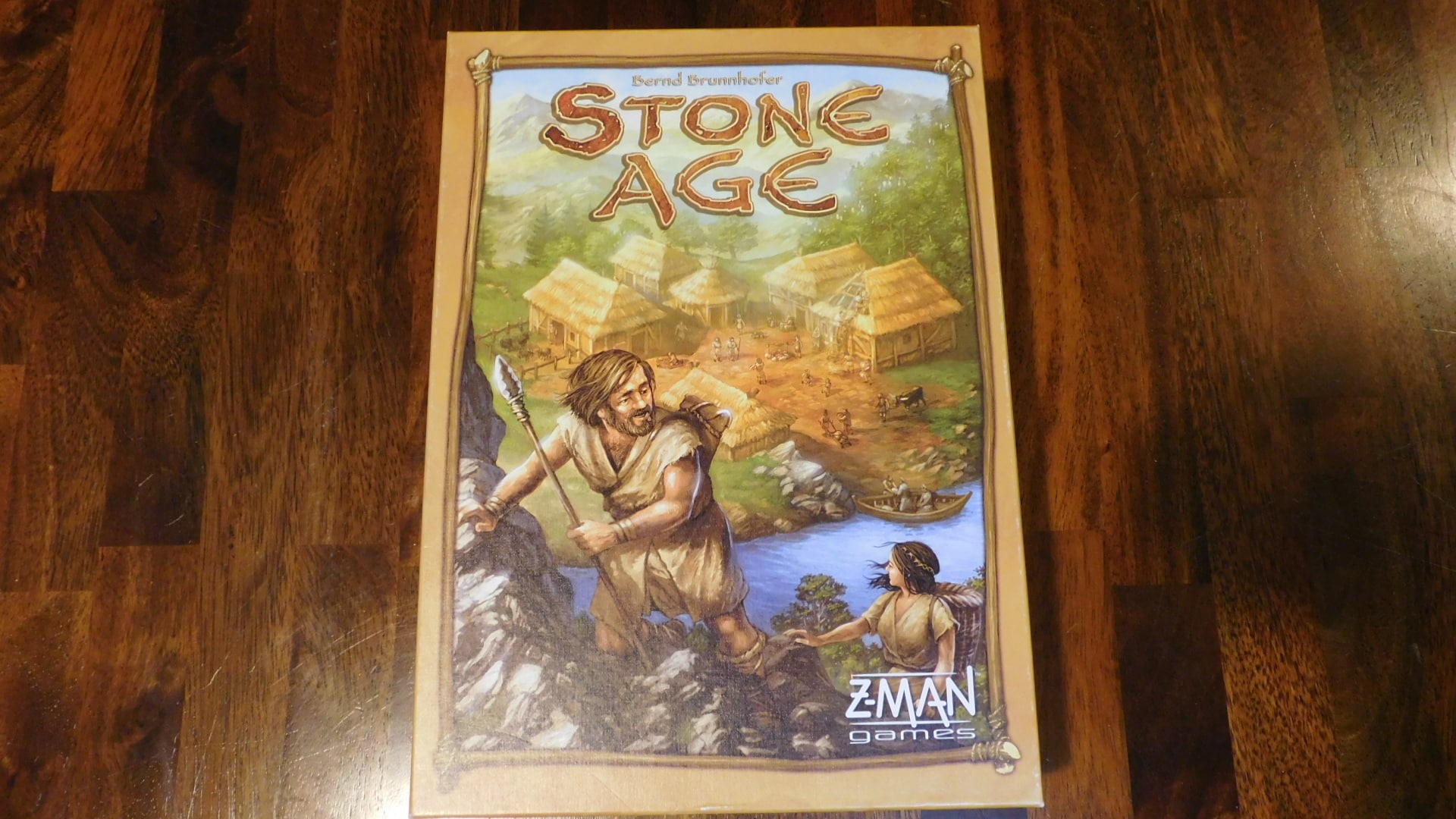Hey, it’s my Stone Age review! That’s right, today I’m reviewing Stone Age. Is this game showing its age or has it aged well? Let’s see!
Stone Age is a worker placement game in which you’re trying to score the most points. It has a prehistoric theme that works but not as well as other themes, but the gameplay and art are excellent. Placing workers, building up your tribe, rolling the dice in the leather dice cup, and scoring at the end of the game are all satisfying parts of this great game.
Table of Contents
Some Background About Stone Age Before The Review
Stone Age came out in 2008 and was published by Z-Man Games. It was designed by Bernd Brunnhofer, and the art was done by Michael Menzel. By the way, if you get a chance, look at other games Michael Menzel has done art for. It’s like staring at high-quality paintings.
Stone Age Overview
Firstly, let’s get to the overview.
Back-Of-The-Box Facts About Stone Age
- Player Count: 2-4
- Time To Play: 60-90 minutes
- Age Range: 13 and up
- Difficulty: Beginner/Easy
- Price Range: $45-$70
- Release Year: 2008
- Publisher(s): Z-Man Games
- Designer(s): Bernd Brunnhofer
- Artist(s): Michael Menzel
- Expansion(s): Stone Age: The Expansion
- Where To Buy: Amazon, Asmodee Store, Board Game Bliss
What Comes In The Box?

In Stone Age’s box, you get over 100 wooden pieces that are different-colored meeples (they are shaped like people) and resources such as stone, wood, brick, and gold. You also get house tiles, cards, dice, a leather dice cup, player boards, food tokens, the main game board, and the rulebook.
All in all, this is a lot of good stuff here.
Theme
The theme of Stone Age is that you’re a prehistoric tribe trying to survive and flourish. Your goal is to have enough food for your people, grow your population, and build a nice village for them to live in.
How To Play Stone Age

Stone Age goes indefinitely until one of two things happens. Either you can’t fill all 4 civilization card spots with civilization cards or at least one of the building tile spots is empty. Interestingly, if the first end-game condition happens then the game is over immediately. If the second happens, then the current round finishes out.
Each turn, starting with the start player (which rotates clockwise each turn), players will place one or more of their meeples on an available spot on the board. There are spots for collecting resources, constructing buildings, getting civilization cards, growing your population, collecting food, making it easier to feed your people, and getting tools.
Players will keep placing meeples until everyone has placed all of them, then, again in turn order, players will take all their actions in any order they choose.
Taking Actions In Stone Age

Here’s where Stone Age gets interesting. Because you can choose to take your actions in any order, that means that sometimes you might place a meeple on a space that you can’t use until you take your other actions first. It’s also possible you don’t get what you need to use that spot, so you end up wasting a whole action because of it.
When you use your meeples who are on the gathering resources or food spots, you roll as many dice as you have meeples in that spot. You do this by placing the dice in the leather dice cup, shaking it around, then flipping it over. You add up all the dice, then divide that total by whatever number is associated with that spot.
Here’s an example. Say you put two meeples on the wood spot. When you roll, you roll dice.
Now, let’s say you got a total of 6. Well, since wood costs 3 per each wood, that means you could collect 2.
Now, what if you rolled a 5 instead? Well, either you only get 1 piece of wood or, if you have a tool, you can use the tool to add to the dice roll. The tools are a nice little touch that helps mitigate dice rolls in this game.
End-Game Scoring
You score points in 2 ways in Stone Age. One is by building buildings. Those buildings are for flat points, which you get right away. The other is through your civilization cards.
Civilization cards have little multipliers on them that give you points at the end of the game. For example, it might show 1 person times tools. That means that at the end of the game you get points for that card equal to how many meeples you have times the total value showing on all your tools.
You also get 1 point per unused resource.
Stone Age Review
Stone Age has been around for a long time. Does that mean it’s a modern classic or is it outdated? Let’s take a look.
Art
There’s no question that Stone Age’s art is incredible. Michael Menzel always paints masterpieces on the board, and Stone Age is no exception to this. It reminds me a bit of Alex Ross and how he paints comic book panels.
For some, this may be off-putting because it feels too fancy, but for me, it’s a nice treat. I also think it works well in Stone Age, giving it a kind of dreamy feel.
Components
The components are top-notch in Stone Age. The leather cup is solid, the dice are good, and the cards, tiles, tokens, and wooden pieces are all good too. You feel like you’re playing with high-quality stuff, which fits in nicely with the art.
Theme
The prehistoric theme is not one that’s done all that often. It’s also one that I’m not interested in. However, it works here.
I like the idea of using primitive tools and materials to build things. In most games, I don’t like the cost of feeding my people (am I a monster?!), but in this game, it doesn’t ever get in the way, and I always feel like I can strategize for this appropriately.
My In-Depth Take on Stone Age’s Theme
However, I don’t think the theme of surviving and flourishing comes through. This game reminds me of Caverna in a way. Caverna, by the way, is another worker placement game that has some similarities with Stone Age, although it’s by far way more complex. In the end, both games, for me, become about getting points.
The food tokens even tie into this because that’s the only consequence as a result of not feeding your people: you lose points. Getting civilization cards doesn’t meaningfully change the way you play the game other than to give you more points or maybe adjust your strategy slightly to maximize your point opportunities from those cards.
The tools you get adjust your dice, which lets you get more resources. Those resources are then used to build buildings, but in the end, the goal is to get more points.
Still, I like what this game has become for me. It’s not just about the points even though it mostly still is. It has a pleasant, laid-back feel that other games don’t. I may not feel like I’m keeping these people alive and helping them to develop their civilization, but I do feel like I’m achieving something with them, and it’s a lot of fun to do so.
Gameplay
The gameplay is fast in Stone Age. Since you can only do one thing on your turn at a time, gameplay comes back around to you quickly. Even when someone is taking all their actions, it never takes so long that you feel bored.
Also, rolling the dice is just plain fun.
Stone Age: My Rating
On a scale of Don’t Buy, Wait For A Sale, or Buy, I rate Stone Age a buy. Here’s why.
Stone Age might be an older game, but in all the times I’ve played this I have yet to be disappointed or bored. The art is beautiful, the theme is unique even if it doesn’t come through super well, and it plays quickly. It reminds me of an older and easier version of Architects Of The West Kingdom.
Games like these fit a nice niche where tons of people can play them. They’re smooth and offer lots of options for strategies. There are moments where you laugh and admire someone’s play, and it’s always great when someone gets the dice roll they’re looking for.
Plus, the end-game scoring adds some tension to the game because you’re never quite sure who is going to win. And it’s usually pretty close too.
Now, would I recommend this game over more modern worker placement games? Yeah, I would. Not all of them, but this is a great game that has stood the test of time, and you can’t say that about every other game in the same genre.
Where To Buy Stone Age
Here’s where you can get this great little game:
Did You Know?
(Each time you refresh the page you will get a new “Did You Know” fact!)
Did you know that the biggest board game convention in the world is in Germany? It’s called Internationale Spieltage SPIEL but is usually called Essen Game Fair. It takes place in Essen, Germany, and features over 1,000 exhibitors from lots of countries. It has also regularly had over 100,000, or sometimes over 200,000 people attend.
Conclusion: Stone Age Review
So, there you have it, my Stone Age review. I do enjoy this game, and I look forward to playing it again in the future, whenever that is. I hope you do too.
On that note, are you interested in playing Stone Age? Let us know your thoughts and why in the comments below!
And, as always, keep on gaming, maniacs.

